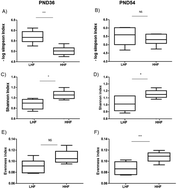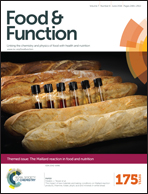Antioxidant properties of formula derived Maillard reaction products in colons of intrauterine growth restricted pigs
Abstract
Objective: the present study has been conducted to evaluate the impact of the consumption of high MRP formula on changes in the microbiota and the oxidative status, during development, in the colons of intrauterine growth restricted (IUGR) juvenile pigs. Methods: over a 3-week period, fifteen-day old piglets received formula with two different heat treatments. A formula heated at high temperature (HHF, n = 8) and another one heated at a low temperature (LHF, n = 8). After weaning, animals were fed, ad libitum, a solid diet until postnatal day 54 (PND54). The diversity and composition of the major microbiota were analyzed by CE SSCP and qPCR at postnatal day 36 (PND36) and PND54. Protein oxidation levels, glutathione peroxidase (GPX) activity, catalase (CAT), manganese dependent superoxide dismutase (Mn SOD), NFκB and inducible nitric oxide synthase (iNOS) gene expression were measured in the colon at the juvenile stage (PND54). Results: HHF resulted in a significant decrease in bacterial diversity in the colon at PND36. An increase in the total count of Bifidobacteria, Lactobacillus, Bacteroidetes and Enterobacteria, without major changes in total microbiota was evidenced by qPCR, suggesting qualitative changes in the bacterial population of the HHF group. The imbalance of microbiota observed at PND36 was significantly modified at PND54, when animals received a solid diet. Colon GPX activity (p < 0.05) and gene expression of CAT and iNOS were significantly (p < 0.05) upregulated in the HHF group. No differences in the total protein oxidation and carbonyl score were found in the HHF group. Colon redox enzyme gene expression and pro-inflammatory factor NFκB negatively correlated (p < 0.05) with the bacterial population, suggesting the involvement of certain phyla in controlling the oxidative status of the IUGR piglets, fed on the high AGE formula. Conclusion: during development, consuming a high load MRP formula was associated with a major modification in the diversity and composition of the microbiota. The onset of an IUGR adaptive oxidant defense mechanism was found to counteract the oxidative stress induced by the presence of MRPs in formula.

- This article is part of the themed collection: The Maillard reaction in food and nutrition

 Please wait while we load your content...
Please wait while we load your content...